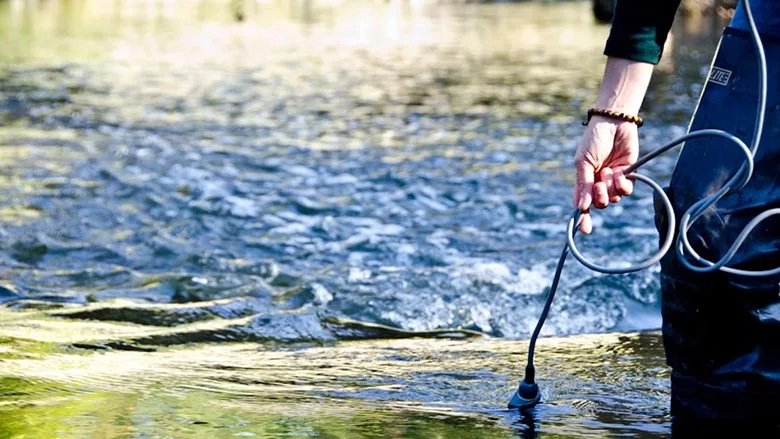EPA Seeks Letters of Interest for Credit to Fund Water-Infrastructure Projects

EPA Region 7 scientists sample for water quality in Indian Creek in Kansas City, Missouri.
Photo courtesy of US EPA and Shannon Bond
The Environmental Protection Agency (EPA) is now accepting letters of interest (LOI) from prospective borrowers for two loan programs that will fund water, wastewater and storm-water infrastructure projects by state, local, and tribal governments, and from other entities such as partnerships.
On Sept. 9, 2024, the EPA posted two Federal Register notices announcing it is accepting LOIs for each loan program. The primary purpose of the LOI is to provide adequate information to EPA to determine eligibility of the prospective borrowers, and of their proposed projects, according to EPA.
The programs and information on each are:
The primary purpose of the LOI is to provide adequate information to EPA to determine eligibility of the prospective borrowers, and of their proposed projects.
- The Notice of Funding Availability for Credit Assistance Under the Water Infrastructure Finance and Innovation Act (WIFIA) Program seeks LOIs from prospective borrowers seeking credit assistance from EPA, which estimates approximately $6.5 billion might be lent to help finance approximately $13 billion in water infrastructure investment. WIFIA established the federal credit program for water and wastewater infrastructure projects by local, state, and tribal governments, and other entities such as partnerships, joint ventures and corporations and trusts.
- The Notice of Funding Availability for Credit Assistance Under the State Infrastructure Financing Authority Water Infrastructure Finance and Innovation Act (SWIFIA) Program seeks LOIs from prospective state infrastructure financing authority borrowers needing credit assistance from the EPA, which estimates that it may lend approximately $1 billion to help finance approximately $2 billion in water infrastructure investment.
Both notices of funding availability (NOFA) say LOIs submitted after Oct. 1, 2024—the start date of the federal fiscal year—will be reviewed using the scoring criteria outlined in each NOFA.
Prospective borrowers seeking loans or credit assistance under the WIFIA or SWIFIA programs should be aware that EPA wants the funding provided to be used to support projects that implement five Biden administration priorities. Those priorities are:
- Increasing Investment in Economically Stressed Communities; which are projects that address the needs of economically stressed and disadvantaged communities and ensure those communities benefit from investments in water infrastructure, and improve the public health and livability of these communities.
- Making Rapid Progress on Lead Service Line Replacement; as many drinking water systems still have lead service lines and there is no safe level of lead in drinking water, EPA encourages the submission of drinking water infrastructure projects that will help make rapid progress on replacing lead service, which can be an effective method to reduce drinking water lead levels. Because of this, WIFIA-funded projects involving lead service line replacement should include a plan to conduct full lead service line replacement.
- Addressing Perfluoroalkyl and Polyfluoroalkyl Substances (PFAS) and Emerging Contaminants; EPA encourages the submission of projects that focus on reducing exposure to PFAS and other emerging contaminants in drinking water and/or projects that help address discharges of emerging contaminants from wastewater and/or storm-water systems.
- Strengthening Climate Resilience in the Water Sector; EPA supports long-term strategies to create a more resilient water infrastructure by addressing the impacts of extreme weather. This includes projects that protect against drought through conserving water, projects that promote water efficiency and reuse, and protect and diversify communities’ sources of water. This also includes projects that address areas experiencing sustained or intermittent increases in water flow, such as projects that address flood risks due to storm-water, and the impacts of combined sewer overflows, and septic to sewer efforts where septic systems are undermined by rising groundwater. Such projects can help communities address water quantity and quality concerns. Supporting One Water Innovation and Resilience; a defining features of WIFIA is the broad range of eligible projects that EPA can fund to flexibly support priority needs. EPA encourages borrowers to submit applications for water infrastructure projects that are new and innovative in regard to energy efficiency, such as onsite wind or solar energy as well as methane digesters or similar projects that work to reduce overall greenhouse gas emissions and may also support energy independence at the system level. In addition, EPA encourages the submission of water infrastructure projects that are more resilient to all threats—whether they are natural disasters or threats such as bioterrorism and cyber-attacks.
Prospective borrowers seeking WIFIA credit assistance from the EPA must submit a LOI describing the project’s fundamentals and that addresses the WIFIA selection criteria. Prospective borrowers must utilize the WIFIA LOI form and follow the guidelines contained on the WIFIA program website.
Prospective borrowers seeking a SWIFIA loan need to submit a LOI using the SWIFIA LOI form found at the WIFIA Program website. Prospective borrowers are encouraged to review the WIFIA program handbook to help create the best justification possible for the project and a cohesive and comprehensive LOI.
The EPA says it will evaluate a project based on the information provided in the LOI, and if deemed appropriate to receive funding assistance, EPA will invite prospective borrowers to submit applications for their projects.
Looking for a reprint of this article?
From high-res PDFs to custom plaques, order your copy today!





